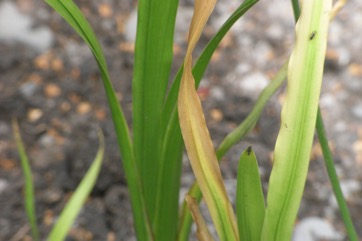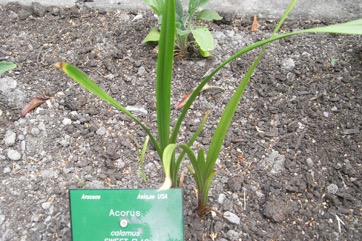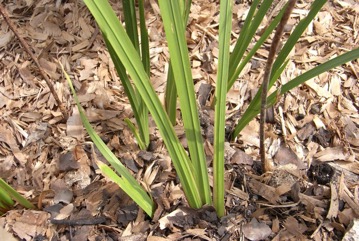Calamus, Sweet flag

Its natural range is the warm temperate regions of Iran and India. They are found throughout the Philippines both cultivated and wild, growing in swamps. In Papua New Guinea it grows from sea level to 2600 m altitude. It can tolerate frost but cannot tolerate drought. It normally occurs in ditches, swamps, and on the edges of lakes and streams. It grows in wetland. It grows best in water no deeper than 22 cm. Often the plant grows in dense pure stands. It is mostly in places with a temperature below 20°C. It suits hardiness zones 3-10.
Also known as:
Ajer, Ayer, Bach, Baje gida, Bas, Boch, Bojho, Bos, Changpu, Flagroot, Fortunate bullrush, Huvagoh, Jaringao, Jeringau, Kalmos, Kalmus, Lepiech, Lin-lay, Lin-ne, Lubigan, Myrtle flag, Pravi kolmež, Puskvorec obecny, Sweet cane, Sweet sedge, Vacha, Vasa, Vasambu, Vavambu, Vayambu, Vekhand, Wan nam
Synonyms
- Acorus asiaticus Nakai
- Acorus terrestris Spreng.
- and others
Edible Portion
- Roots, Rhizome, Leaves, Stems, Herb, Spice
Where does Calamus grow?
Found in: Afghanistan, Asia, Australia, Austria, Balkans, Bangladesh, Belarus, Bhutan, Bosnia, Brazil, Britain, Canada, China, Czech Republic, Denmark, Egypt, Estonia, Europe, France, Germany, Himalayas, Hungary, India, Indochina, Indonesia, Iran, Ireland, Italy, Japan, Korea, Laos, Lithuania, Luxembourg, Macedonia, Malaysia, Maldives, Mongolia, Myanmar, Nepal, Netherlands, New Zealand, North Africa, North America, Northeastern India, Pacific, Pakistan, Papua New Guinea, PNG, Philippines, Philippines, Poland, Russia, Scandinavia, SE Asia, Serbia, Siberia, Slovenia, South America, Spain, Sri Lanka, Sweden, Thailand, Turkey, Ukraine, United States, Vietnam, Yugoslavia
Notes: 1% volatile oil; a bitter glucoside - acorin; There is only one genus in the Acoraceae. There are 2-4 Acorus species. It has a long history of use for perfume and medicine.
Status: It is not known if it is used for food in Papua New Guinea.
Growing Calamus, Sweet flag
Cultivation: It can be grown by dividing the rootstock. It can also be grown by seeds.
Edible Uses: The underground stems are ground and used to flavour food. They can be eaten raw. They have a gingery peppery taste. It should probably only be eaten sparingly with caution. They contain a bitter glucoside called acorin. The forms of Acorus in Asia contain a chemical called asarone which causes cancer. The centre of the above ground section can be eaten. The underground stem can be washed, peeled, chopped into 1 cm long pieces and cooked for 20 minutes with several changes of water then simmered for 20 minutes in sugar syrup to produce candy.
Production: Tender young stalks are harvested. The young underground stem needs to be separated from the roots and pulled or dug out.
Nutrition Info
per 100g edible portion| Edible Part | Energy (kcal) | Protein (g) | Iron (mg) | Vitamin A (ug) | Vitamin c (mg) | Zinc (mg) | % Water |
|---|---|---|---|---|---|---|---|
| Rhizome - caution | - | - | - | - | - | - | |
| Leaves | - | - | - | - | - | - | |
| Stems | - | - | - | - | - | - |
Calamus, Sweet flag Photos



References
Ambasta S.P. (Ed.), 2000, The Useful Plants of India. CSIR India. p 11
Aryal, K. P., et al, 2018, Diversity and use of wild and non-cultivated edible plants in the Western Himalaya. Journal of Ethnobiology and Ethnomedicine (2018) 14:10
Baro, D., Baruah, S. and Borthukar, S. K. 2015, Documentation on wild vegetables of Baksa district, BTAD (Assam). Scholars Research Library. Archives of Applied Science Research, 2015, 7 (9):19-27
Beckstrom-Sternberg, Stephen M., and James A. Duke. "The Foodplant Database." http://probe.nalusda.gov:8300/cgi-bin/browse/foodplantdb.(ACEDB version 4.0 - data version July 1994)
Behera, K. K. et al, 2008, Wild Edible Plants of Mayurbhanj District, Orissa, India. J. Econ. Taxon. Bot. Vol. 32 (Suppl,) pp 305-314
Bircher, A. G. & Bircher, W. H., 2000, Encyclopedia of Fruit Trees and Edible Flowering Plants in Egypt and the Subtropics. AUC Press. p 7
Bodkin, F., 1991, Encyclopedia Botanica. Cornstalk publishing, p 46
Borrell, O.W., 1989, An Annotated Checklist of the Flora of Kairiru Island, New Guinea. Marcellin College, Victoria Australia. p 14, 156
Bremness, L., 1994, Herbs. Collins Eyewitness Handbooks. Harper Collins. p 137
Brickell, C. (Ed.), 1999, The Royal Horticultural Society A-Z Encyclopedia of Garden Plants. Convent Garden Books. p 75
Brouk, B., 1975, Plants Consumed by Man. Academic Press, London. p 285
Brown, D., 2002, The Royal Horticultural Society encyclopedia of Herbs and their uses. DK Books. p 101
Brown, W.H., 1920, Wild Food Plants of the Philippines. Bureau of Forestry Bulletin No. 21 Manila. p 30
Burkill, I.H., 1966, A Dictionary of the Economic Products of the Malay Peninsula. Ministry of Agriculture and Cooperatives, Kuala Lumpur, Malaysia. Vol 1 (A-H) p 34
Cundall, P., (ed.), 2004, Gardening Australia: flora: the gardener's bible. ABC Books. p 95
Deka, N. & Devi, N., 2015, Wild edible aquatic and marshland angiosperms of Baka district, BTC area, Assam, India. Asian J. Plant Sci. Res. 5(1):32-48
Denes, A., et al, 2012, Wild plants used for food by Hungarian ethnic groups living inthe Carpathian Basin. Acta Societatis Botanicorum Poloniae 81 (4): 381-396
Duke, J.A., 1992, Handbook of Edible Weeds. CRC Press. p 18
Elias, T.S. & Dykeman P.A., 1990, Edible Wild Plants. A North American Field guide. Sterling, New York p 133
Esperanca, M. J., 1988. Surviving in the wild. A glance at the wild plants and their uses. Vol. 2. p 274
Facciola, S., 1998, Cornucopia 2: a Source Book of Edible Plants. Kampong Publications, p 23
Hani Medicine of Xishuangbanna, 1999, p 367
Hedrick, U.P., 1919, (Ed.), Sturtevant's edible plants of the world. p 24
Hemphill, I, 2002, Spice Notes. Macmillan. p 91
Hepper, E.N., 1993, Illustrated Encyclopedia of Bible Plants, IVP, England. p 144
Hossain, U. & Rahman, A., 2018, Study and quantitative analysis of wild vegetable floral diversity available in Barisal district, Bangladesh. Asian J. Med. Biol. Res. 2018, 4 (4), 362-371
Huxley, A. (Ed.), 1977, The Encyclopedia of the Plant Kingdom. Chartweil Books. p 186
Irving, M., 2009, The Forager Handbook, A Guide to the Edible Plants of Britain. Ebury Press p 315
Johns, R.J. & Hay, A., 1976, Monocotyledons of Papua New Guinea. Part 1 , Forestry College Bulolo, PNG p 35
Kalle, R. & Soukand, R., 2012, Historical ethnobotanical review of wild edible plants of Estonia (1770s-1960s) Acta Societatis Botanicorum Poloniae 81(4):271-281
Khan, M. & Hussain, S., 2014, Diversity of wild edible plants and flowering phenology of district Poonch (J & K) in the northwest Himalaya. Indian Journal of Sci, Res. 9(1): 032-038
Kiple, K.F. & Ornelas, K.C., (eds), 2000, The Cambridge World History of Food. CUP p 432, 1862
Kybal, J., 1980, Herbs and Spices, A Hamlyn Colour Guide. p 16
Leach, G.J., and Osborne, P.L., 1985, Freshwater Plants of Papua New Guinea. UPNG Press, p 86
Lembaga Biologi Nasional, 1977, Ubi-Ubian, Balai Pustaka, Jakarta. p 22
Lim, T. K., 2015, Edible Medicinal and Non Medicinal Plants. Volume 9, Modified Stems, Roots, Bulbs. Springer p 3
Łukasz Łuczaj and Wojciech M Szymański, 2007, Wild vascular plants gathered for consumption in the Polish countryside: a review. J Ethnobiol Ethnomedicine. 3: 17
Łuczaj, L., et al, 2013, Wild edible plants of Belarus: from Rostafiński’s questionnaire of 1883 to the present. Journal of Ethnobiology and Ethnomedicine 2013, 9:21
Lukasz, L., 2016, Wild Edible Plants Traditionally Used in Poland.
Manandhar, N.P., 2002, Plants and People of Nepal. Timber Press. Portland, Oregon. p 70
Monsalud, M.R., Tongacan, A.L., Lopez, F.R., & Lagrimas, M.Q., 1966, Edible Wild Plants in Philippine Forests. Philippine Journal of Science. p 443
Pagag, K. & Borthakur, S. K., 2012, Wild edible wetland plants from Lakhimpur district of Assam, India. Pleione 6(2): 322 - 327
Peekel, P.G., 1984, (Translation E.E.Henty), Flora of the Bismarck Archipelago for Naturalists, Division of Botany, Lae, PNG. p 75, 74
Pieroni, A. & Soukand, R., 2018, Forest as Stronghold of Local Ecological Practice: Currently Used Wild Food Plants in Polesia, Northern Ukraine. Economic Botany, XX(X) pp. 1-21
Plants for a Future database, The Field, Penpol, Lostwithiel, Cornwall, PL22 0NG, UK. http://www.scs.leeds.ac.uk/pfaf/
PROSEA handbook Volume 13 Spices. p 273
Purseglove, J.W., 1972, Tropical Crops. Monocotyledons. Longmans p 60
READ,
Redzic, S. J., 2006, Wild Edible Plants and their Traditional Use in the Human Nutrition in Bosnia-Herzegovina. Ecology of Food and Nutrition, 45:189-232
Romanowski, N., 2007, Edible Water Gardens. Hyland House. p 47
Samy, J., Sugumaran, M., Lee, K. L. W., 2009, Herbs of Malaysia, Marshall Cavendish. p 32
Samydurai, P., et al, 2012, Wild habits of Kolli Hills being staple food of inhabitant tribes of eastern Ghats, Tamil Nadu, India. Indian Journal of Natural Products and Resources. 3(3) September 2012 pp 432-437
Seidemann J., 2005, World Spice Plants. Economic Usage, Botany, Taxonomy. Springer. p 5
Shikov, A. N. et al, 2017, Traditional and Current Food Use of Wild Plants Listed in the Russian Pharmacopoeia. Frontiers in Pharmacology. Vol. 8 Article 841
Simkova, K. et al, 2014, Ethnobotanical review of wild edible plants used in the Czech Republic. Journal of Applied Botany and Food Quality 88, 49-67
Slocum, P.D. & Robinson, P., 1999, Water Gardening. Water Lilies and Lotuses. Timber Press. p 90
Soukand, R., et al, 2017, Multi-functionality of the few: current and past uses of wild plants for food and healing in Liubań region, Belarus. Journal of Ethnobiology and Ethnomedicine (2017) 13:10
Sp. pl. 1:324. 1753
Swapna, M. M. et al, 2011, A review on the medicinal and edible aspects of aquatic and wetland plants of India. J. Med. Plants Res. 5 (33) pp. 7163-7176
Tyagi, R. K., et al, 2004, Conservation of Spices Germplasm in India. Indian J. Plant Genet. Resour. 17(3): 163-174
UPHOF
Urgamal, M., et al, 2014, Conspectus of the Vascular Plants of Mongolia. Mongolia Academy of Sciences Insitute of Botany and National University of Mongolia Department of Biology. p 37
Valder, P., 1999, The Garden Plants of China. Florilegium. p 228
Vermeulen, N, 1998, The Complete Encyclopedia of Herbs. Rebo Publishers. p 23
World Checklist of Useful Plant Species 2020. Royal Botanic Gardens, Kew
Zhang, Y., et al, 2014, Diversity of wetland plants used traditionally in China: a literature review. Journal of Ethnobiology and Ethnomedicine 2014, 10:72